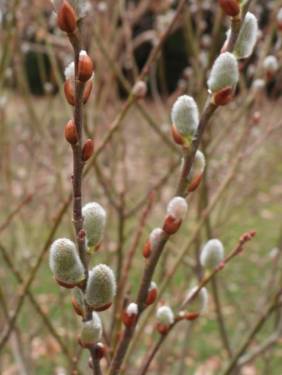Pussy Willow

One of the earliest blooming plants, even though they aren’t what we traditionally think of as blooms, in the landscape is the Pussy Willow. This harbinger of spring is a deciduous shrub native to Nova Scotia, Maryland, Indiana, Missouri, and Iowa. Pussy willows are known for their late winter/early spring display of gray, fuzzy catkins. A catkin is a slim cylindrical flower cluster that is usually wind-pollinated. Before the foliage emerges in the spring, the male trees display long, pearl-gray silky catkins that are approximately 1-1.5” long. This shrub gets its common name from the catkins that are said to resemble a cat’s paw. Pussy willows are dioecious plants, meaning they have male and female plants. Pussy willows are traditionally large multi-stemmed shrubs that range in size from 6-15’ tall. However, they can also be grown in a weeping form on a standard or pruned to maintain a smaller size. This willow prefers moist soils but is more tolerant of dry soils than other varieties. Unfortunately, this plant has numerous issues that can show up, including cankers, powdery mildew, scab, and other insect issues; however, they do make a beautiful shrub in a landscape. Like other willows, they must be kept from sewers, water lines, or drains as the roots seek the water.

Have questions? Contact our office where our Horticulture Extension Agent will assist you with questions.
Phone: (316) 321-9660
Email: callae@ksu.edu